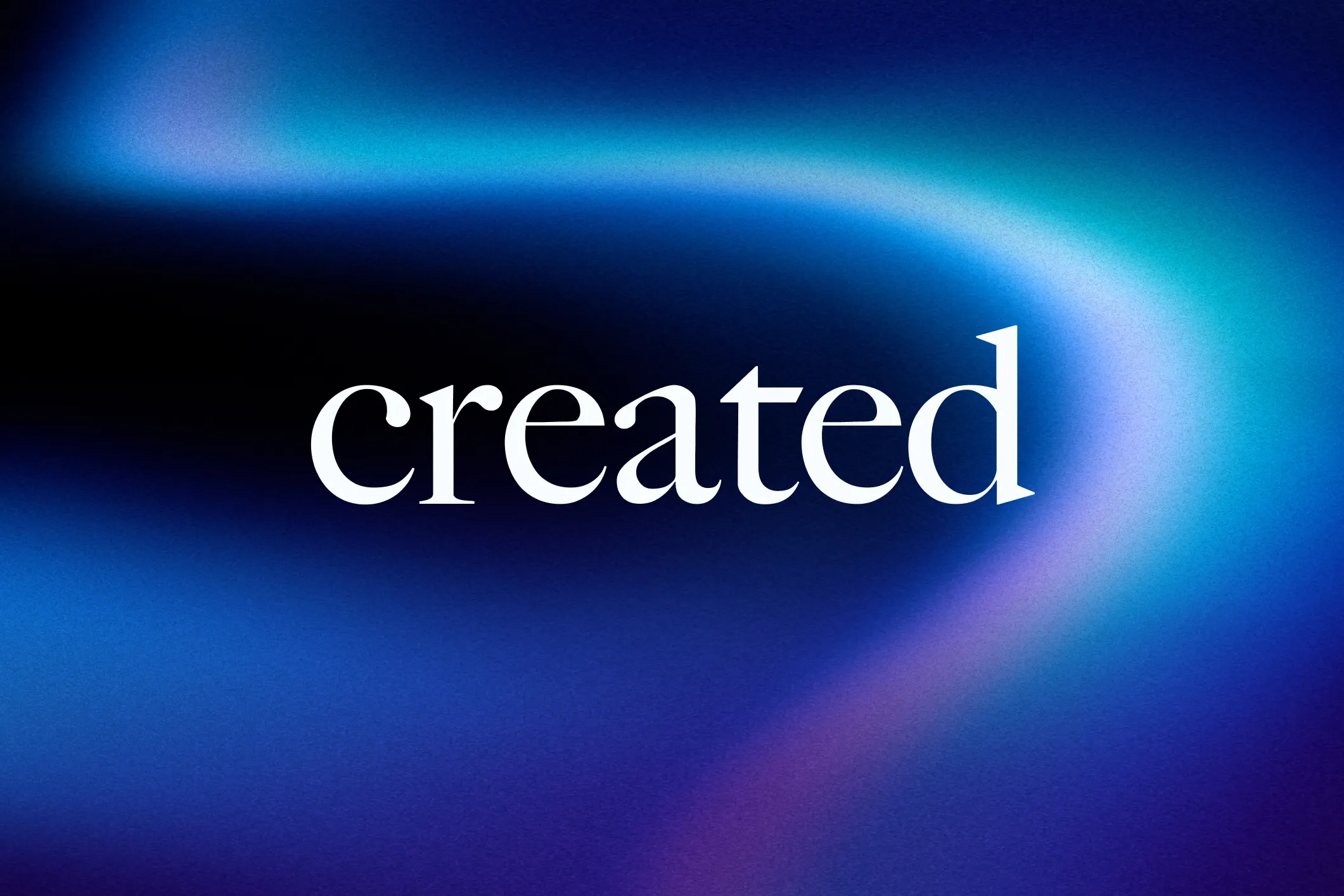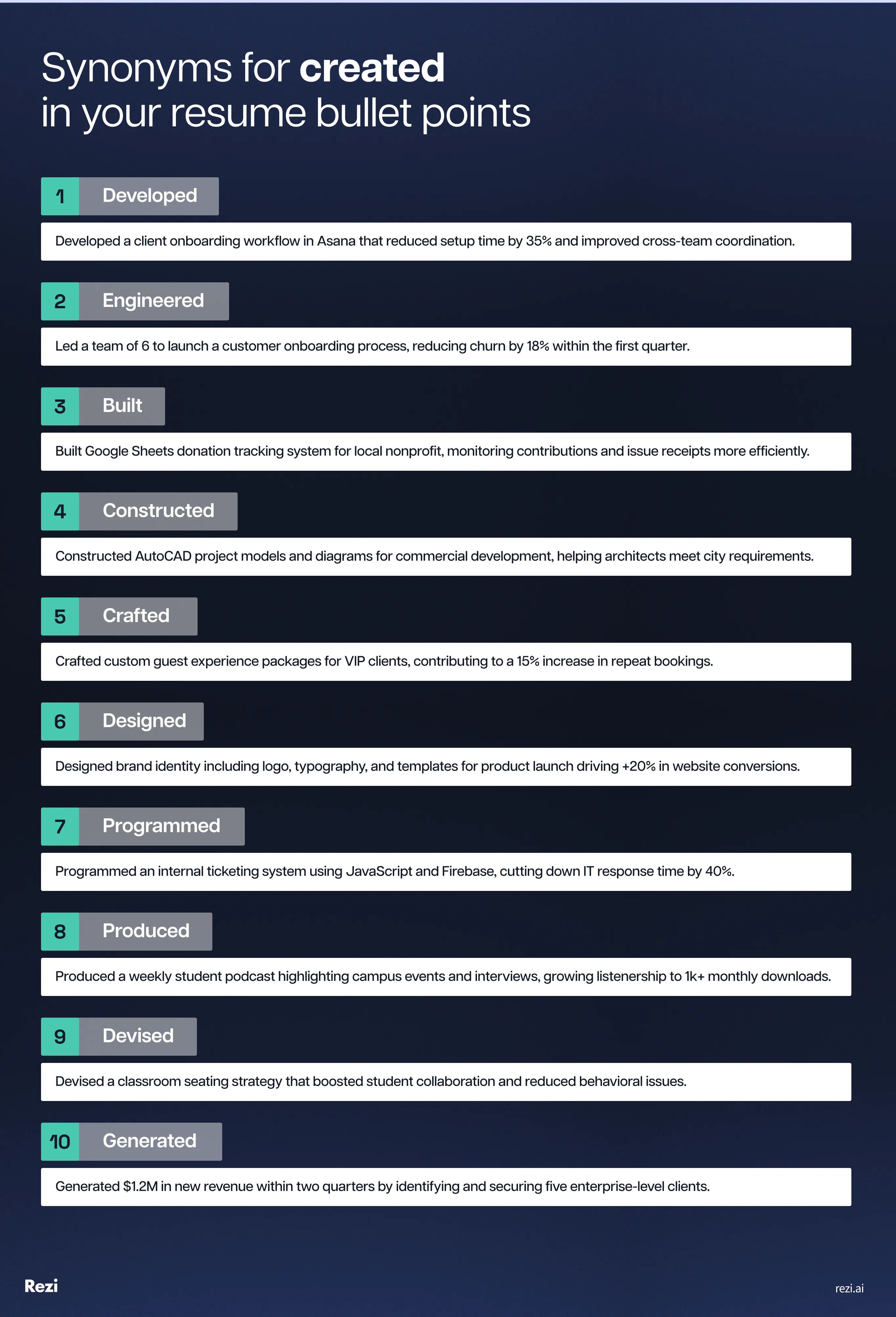Discover 30+ powerful synonyms for “created” to make your resume more specific, impactful, and tailored to your role, with examples to help you use them right.



“Created” is a go-to resume verb — and for good reason. It shows you took the initiative to bring something valuable into existence, whether that’s a new feature, process, campaign, or tool. But when overused, it can start to feel repetitive and lose its punch.
This guide will help you make your resume more engaging with impactful verb choices.
You’ll learn:
- 30+ strong “created” alternatives for all kinds of roles.
- How to use them in resume bullet points.
- When “created” is still your best option.
Need help crafting your resume? Try the Free AI Resume Builder. And check out these helpful guides:
- 35+ Free Professional Resume Templates
- How Many Years Back Should a Resume Go?
- How to Beat Applicant Tracking Systems (ATS)
- How to Write a Resume With No Experience
30+ Resume Synonyms for “Created”
Wondering what to use instead of “created”? It’s a solid start, but there are plenty of sharper verbs that capture exactly how you built, designed, or launched something. Picking the right word can give your experience more clarity and make your resume pop.
Here are some great alternatives to “created”:
Need some help putting these into action? Check out these resume-ready example sentences:

How to Replace “Created” with Synonyms on Your Resume
“Created” is a popular action verb, but using stronger, more precise verbs can make your achievements stand out and sound more impressive.
Here’s how to swap out “created” for a synonym that better reflects your impact:
Developed vs. Created
Using “developed” highlights planning and customization. It suggests that the plans were tailored and refined to achieve a specific outcome.
“Created patient care plans for post-surgery recovery.”
“Developed personalized recovery care plans that improved patient outcomes and reduced readmission rates.”
Drafted vs. Created
“Drafted” sounds more precise and aligned with legal or formal writing. It shows that you put together documents with structure and strategic intent, not just casually or generically.
“Created legal case summaries for court proceedings.”
“Drafted detailed case summaries that supported litigation strategy and streamlined trial preparation.”
Crafted vs. Created
“Crafted” adds a creative and artisan-like tone. It’s great for hospitality or creative fields, where the quality and uniqueness of your work are important.
“Created new cocktail recipes for the seasonal menu.”
“Crafted five original cocktail recipes featured on the seasonal menu, increasing bar sales by 20%.”
Established vs. Created
“Established” conveys authority and permanence. It implies that the protocol wasn’t just made — it became a recognized, lasting standard. Perfect for policy, operations, or compliance-driven work.
“Created a new protocol for infection control.”
“Established a lab-wide infection control protocol that passed all compliance audits with zero deficiencies.”
Formulated vs. Created
“Formulated” suggests analytical thinking and planning. It adds weight in technical or compliance-driven industries where detail and structure are critical.
“Created a safety checklist for site inspections.”
“Formulated a comprehensive site safety checklist that reduced inspection violations by 40%.”
Wrote vs. Created
“Wrote” is clear, direct, and leaves no doubt about your role in creating the content. Pairing it with “curated” also shows you had editorial judgment, not just writing skills, which is a bonus in marketing and content roles.
“Created content for the company blog.”
“Wrote and curated SEO-optimized blog content that boosted organic traffic by 25%.”
Built vs. Created
“Built” has a technical, constructive tone. It works well for dashboards, tools, and systems, suggesting you not only initiated something but also engineered its structure and functionality.
“Created a dashboard to track investment performance.”
“Built a dynamic dashboard to monitor portfolio metrics, enhancing client reporting accuracy.”
Authored vs. Created
“Authored” adds a sense of authority and professionalism, especially when it comes to formal documents like guides, reports, or publications. It highlights that you were the original writer and positions your writing as a trusted resource.
“Created an onboarding guide for junior developers.”
“Authored a technical onboarding guide that reduced ramp-up time for new engineers by 40%.”
Engineered vs. Created
“Engineered” emphasizes your technical expertise and creative problem-solving. It’s a great pick when you’ve built something complex, especially if it involved data, systems, or a bit of math magic.
“Created a tool to calculate construction costs.”
“Engineered a cost estimation tool that improved budget accuracy for commercial builds.”
Designed vs. Created
“Designed” is direct, visual, and widely used in fields like architecture, UX/UI, or interior design. It tells the hiring manager that the aesthetics, functionality, and planning were part of your contribution.
“Created blueprints for a residential building project.”
“Designed architectural blueprints for a 10-unit residential complex, adhering to zoning and code requirements.”
Implemented vs. Created
“Implemented” shows execution and follow-through. You came up with the idea and actually made it happen. It’s a perfect choice for systems, tools, or processes.
“Created a spreadsheet for monthly budget tracking.”
“Implemented a monthly budgeting tool that helped reduce department overspending by 15%.”
Produced vs. Created
“Produced” makes the sentence feel more professional and outcome-focused. It suggests that the lesson plans weren’t just created, but were thoughtfully developed to meet standards and engage students.
“Created lesson plans for middle school science.”
“Produced engaging, standards-aligned science lesson plans for grades 6–8.”
Formed vs. Created
“Formed” conveys that you took initiative and brought people together with intention. You made it happen and probably played a key role in leading or guiding the group.
“Created a team to handle international partnerships.”
“Formed and led a cross-functional team to manage international partner relations and compliance.”
Devised vs. Created
“Devised” highlights smart problem-solving. It demonstrates you came up with a clever solution, which is great for strategy, operations, or customer service roles.
“Created a plan to reduce call center wait times.”
“Devised an optimized call routing strategy that cut customer wait times by 40%”
Prepared vs. Created
“Prepared” is more formal and accurate for reporting or financial work. It implies precision, compliance, and attention to detail, which adds credibility in finance, law, or admin-heavy roles.
“Created financial statements for quarterly reports.”
“Prepared detailed quarterly financial statements in accordance with GAAP standards.”
Best “Created” Synonym Examples
Not all “created” moments are the same — some are more hands-on, some more strategic.
Let’s dive into examples that prove how different synonyms can shape the way your accomplishments come across. Use these as inspiration to find the word that best matches your impact.
1. Developed
“Developed” highlights progress and thoughtful execution — it’s great when you’ve built something from scratch or improved it over time. It works well in tech, healthcare, marketing, education, and strategic roles because it implies ownership, iteration, and long-term thinking.
Examples:
• Developed a training curriculum for 20+ new hires, reducing onboarding time by 30%.
• Developed a data entry system that minimized billing errors in patient records.
• Involved in a student-led initiative that developed a peer mentorship program across three departments.
2. Built
“Built” is practical and hands-on — it tells employers you made something functional, whether that’s a tool, report, system, or even a physical space. It’s especially effective in tech, operations, finance, or construction settings, where creating reliable, usable outputs is key.
Examples:
• Built a custom Salesforce workflow to automate lead routing across three teams.
• Built a financial dashboard to help executives track KPIs in real time.
• Built stage sets and props for university theater productions as part of the drama club.
3. Designed
“Designed” is great when your work was intentional, visual, and user-focused. It’s perfect for UX/UI, architecture, marketing, and education roles because it conveys thought, planning, and creativity, especially when you’re making something people need to understand or use.
Examples:
• Designed a series of email templates that increased campaign click-through rates by 18%.
• Designed a floor plan for a community center renovation project under tight spatial constraints.
• Designed and illustrated an infographic used in a campus-wide sustainability campaign.
4. Engineered
“Engineered” indicates a sense of technical and problem-solving ability. It shows you applied logic, precision, and structure. This verb shines in engineering, manufacturing, finance, and data-driven tech roles where accuracy and optimization matter.
Examples:
• Engineered a machine-learning model that predicted churn with 85% accuracy.
• Engineered a lightweight frame for electric scooters, reducing material costs by 22%.
• Engineered a DIY solar panel kit as part of an environmental science research project.
Learn how to show off the 13 Best Technical Skills for a Resume.
5. Constructed
“Constructed” is ideal when you’ve physically built or pieced together something complex and structured. It’s common in construction, engineering, event planning, or operations resumes, anywhere hands-on work or logistical planning is front and center.
Examples:
• Constructed a new warehouse layout that boosted product retrieval times by 40%.
• Constructed a customer-facing FAQ system using Zendesk to reduce support tickets.
• Constructed 50+ props and set pieces for community theatre productions, improving the stage visuals and supporting smooth scene changes.
6. Crafted
“Crafted” adds a creative, personal touch. It’s ideal when your efforts required precision, care, or originality. This verb is great for marketing, hospitality, content creation, and design roles, where highlighting finesse and intention can make your contributions stand out.
Examples:
• Crafted social media captions that reflected brand voice and boosted engagement by 50%.
• Crafted personalized welcome letters for hotel guests, improving guest ratings.
• Crafted a persuasive speech that won first place in a regional debate tournament.
7. Produced
“Produced” is about deliverables. It’s direct, action-focused, and emphasizes that you followed through on your work. This one’s especially effective in media, education, content, and operations — any role where quantity, deadlines, or logistics are in play.
Examples:
• Produced over 50 pieces of long-form content optimized for SEO and user engagement.
• Produced weekly client reports summarizing campaign performance and ROI.
• Produced a student-led podcast featuring interviews with local entrepreneurs.
8. Programmed
“Programmed” is perfect when you want to clearly outline your technical skills, especially in software development, automation, or data science. It tells recruiters exactly what you did and that you have the coding skills to do it again.
Examples:
•Programmed a Python script that automated customer invoicing, saving 10+ hours/month.
• Programmed a mobile app for local farmers to track harvest schedules and costs.
• Programmed an interactive quiz game as part of a computer science capstone project.
Check out how to highlight Computer Skills on Your Resume.
9. Devised
“Devised” suggests strategy and creative problem-solving. It’s a great pick when you developed a unique or smart solution, especially in consulting, customer support, education, and operations, where innovation and adaptability count.
Examples:
• Devised a rotating shift system for restaurant staff that improved schedule fairness and reduced last-minute call-outs.
• Devised a scheduling system for volunteers at a local shelter, improving shift coverage.
• Devised a remote learning plan for ESL students during school closures.
10. Generated
“Generated” puts the focus on outcomes, like when you drove traffic, revenue, leads, or other metrics. It works well in sales, marketing, finance, and business development because it signals that your actions had a measurable, bottom-line impact.
Examples:
• Generated $250K in new client revenue through targeted outreach campaigns.
• Generated weekly reports that identified performance trends across regions.
• Generated student interest by leading weekly STEM workshops in underserved schools.
Read about the Best Skills to Put on a Resume (Examples for All Jobs).
When You Should Still Use “Created” in Your Resume
“Created” isn’t a bad word; it’s just overused. But sometimes, it’s still the best fit for what you did. It’s all about including it where it adds real value.
- Use it when you built something from the ground up. If you launched a new system, product, or process, “created” clearly shows you were the driving force behind it. Just consider whether a synonym like “developed” or “engineered” might add more detail or context.
- Match the verb to your field. “Created” is general, but “programmed,” “crafted,” or “formulated” might sound more relevant depending on your role.
- Skip it if the task was routine. If you followed existing instructions or templates, “created” might be a stretch. In those cases, go with “handled,” “supported,” or “executed” to stay accurate.
- Lead with action verbs in your resume experience section. Verbs like “created” work best at the start of bullet points where you’re showing what you accomplished on your resume, not just listing responsibilities.
- It also fits in your resume summary or objective. You can use “created” to highlight a standout project or result from a previous job, internship, or even coursework if you’re early in your career.
- Numbers make every “created” stronger. Whether you “created a program that cut costs by 20%” or “built a system used by 500+ employees,” quantifying the outcome makes it far more impactful.
- Keep clarity in mind. If a simpler verb like “built” or “designed” gets the point across faster, go with that. You don’t need to overcomplicate it, just be clear and direct.
FAQ
What are weak words in a resume?
Weak words like “helped,” “worked on,” and “responsible for” sound vague and don’t say what you actually did. They leave hiring managers guessing. Instead, go for action verbs on your resume like “managed,” “developed,” or “led,” which highlight your contributions and impact.
What is the proper verb tense to use throughout a resume?
Use the past tense for previous jobs, projects, and internships. For your current role, stick to the present tense for ongoing or regular tasks, but past tense for accomplishments you’ve already completed.
Is a 3-page resume too long?
Usually, yes — if you’re early or mid-career. Aim for one or two pages packed with relevant, targeted content. Three pages can work for senior, academic, or research roles, but if you’re only spilling over by a few lines, trim it down.
For more on this, read How Long Should a Resume Be.
What not to include on a resume?
Leave out your full address (city and state/country is enough), references, and the line “references available upon request.” Skip personal info like age, marital status, or a photo unless required. Also, don’t include unrelated jobs that don’t support your current goals.
What are some key resume tips?
Tailor each resume to the job by using keywords from the job description and focusing on results, not just duties. Start bullets with action verbs and include numbers when possible. Keep the layout simple and readable. Stick to one column, use consistent formatting, and always proofread.



